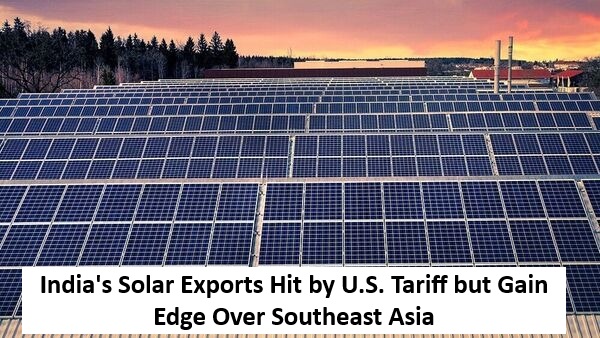
A reciprocal 26% tariff imposed by the United States on Indian solar exports may temporarily slow shipments but could still work in India’s favor. According to stakeholders, the tariff is significantly lower than those levied on Southeast Asian competitors, making Indian solar modules and cells more price-competitive.
In FY25, India is projected to export around 7-8 gigawatts (GW) of solar equipment, with a large portion destined for the U.S., which has limited domestic solar production capacity. India's own manufacturing capacity stands at 74 GW for modules and 25 GW for cells.
Malaysia May Benefit, But India Still Holds Advantage Over Others
While Malaysia’s 24% tariff is slightly lower than India’s, tariffs on other countries like Vietnam (46%), Thailand (36%), and Cambodia (49%) give India a clear pricing edge. A senior executive from a leading solar firm emphasized that India must act swiftly to expand capacity to maintain this advantage.
Ankit Hakhu, Director at Crisil Ratings, stated that the U.S. will likely continue relying on imports and may prefer Indian manufacturers over others due to cost and geopolitical considerations.
Profit Margins Hit, But Domestic Demand and Global Expansion Offer Support
The new tariffs could impact profit margins, as 20–25% of India's solar output is exported, largely to the U.S. However, increasing domestic demand could cushion the decline in export volumes.
Tata Power, for instance, uses all of its 10 GW capacity for domestic consumption. Meanwhile, Waaree Energies Ltd, India’s largest solar exporter to the U.S., is viewing the situation as an opportunity to expand globally and increase manufacturing capacity.
Waaree Expands U.S. Operations Amid Policy Uncertainty
Waaree CEO Amit Paithankar confirmed the company’s Rs 50,000 crore order book (26 GW) includes firm global commitments for the next 1.5 to 2 years. He added that the company is doubling its U.S. plant capacity from 1.6 GW to 3.2 GW to align with U.S. policy changes.
“Our dual approach—manufacturing for the U.S. in the U.S. and for the world in India—ensures optimized supply chains and robust delivery,” Paithankar said.
Concerns Over Dumping and Chinese Rerouting
Despite domestic capacity growth, Chinese modules continue to reach India via rerouting, raising concerns about dumping. India now imports about 60% of its solar modules, down from 80–90% in 2021–2022.
To counteract this, the government has imposed a 20% Basic Customs Duty (BCD) and implemented non-tariff barriers like the Approved List of Models and Manufacturers (ALMM). Starting June 2026, a similar list for cell manufacturers will also be enforced.
Industry Outlook: Scale, Diversify, and Secure
Industry leaders agree that while tariffs impact profitability, they also open new avenues. India must scale solar manufacturing quickly, explore alternative markets, and enhance safeguards against market distortions caused by rerouted Chinese imports.
Read More: Izmo Limited Shares Turn Multibagger with Stunning 12200 Percent Return for Long Term Investors

 Share
Share



